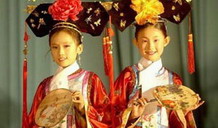The History of Uygur Ethnic Group
Xinjiang has been part of China since ancient times. The Uygurs, together with other ethnic groups, opened up the region and have had very close economic and cultural ties with people in other parts of the country, particularly central China.
Xinjiang was called simply "Western Region" in ancient times. The Jiaohe ruins, Gaochang ruins, Yangqi Mansion of "A Thousand Houses," Baicheng (Bay) Kizil Thousand Buddha Grottoes, Bozklik Grottoes in Turpan, Kumtula Grottoes in Kuqa and Astana Tombs in Turpan all contain a great wealth of relics from the Western and Eastern Han dynasties (206 BC-AD 220). They bear witness to the efforts of the Uygurs and other ethnic groups in Xinjiang in developing China and its culture.
Zhang Qian, who lived in the second century BC, went to the Western Region as an official envoy in 138 and 119 BC, further strengthening ties between China and central Asia via the "Silk Road." In 60 BC, Emperor Xuan Di of the Western Han Dynasty established the Office of Governor of the Western Region to supervise the "36 states" north and south of the Tianshan Mountains with the westernmost border running through areas east and south of Lake Balkhash and the Pamirs.
During the Wei, Jin, Northern and Southern dynasties (220-581) the Western Reigon was a political dependent of the government in central China. The Wei, Western Jin, Earlier Liang (317-376), Earlier Qin (352-394) and Later Liang (386-403) dynasties all stationed troops and set up administrative bodies there. In 327, Zhang Jun of the Earlier Liang Dynasty set up in Turpan the Gao Chang Prefecture, the first of its kind in the region.
In the mid-seventh century, the Tang Dynasty established the Anxi Governor's Office in Xizhou (present-day Turpan, it later moved to Guizi, present-day Kuqa) to rule areas south and north of the Tianshan Mountains. The superintendent's offices in the Pamirs were all under the jurisdiction of the Anxi Governor's Office. In the meantime, four Anxi towns of important military significance – Guizi, Yutian (present-day Hotan), Shule (present-day Kaxgar) and Suiye (on the southern bank of the Chu River) – were established.
In the early eighth century, the Tang Dynasty added Beiting Governor's Office in Tingzhou (present-day Jimsar). The Beiting and Anxi offices, with an administrative and military system under them, implemented effectively the Tang government's orders.
In the early 13th century, Genghis Khan (1162-1227) appointed a senior official in the region. The Yuan Dynasty (1271-1368) established Bieshibali (present-day areas north of Jimsar) and Alimali (present-day Korgas) provinces. The Hami Military Command was set up during the Ming Dynasty (1368-1644). During the Qing Dynasty (1644-1911) the northern part of the Western Region, namely, north of Irtish River and Zaysan Lake, was under Zuo Fu General's Office in Wuliyasu. The General's Office in Ili exercised power over areas north and south of the Tianshan Mountains, east and south of Lake Balkhash and the Pamirs. Xinjiang was made a province in 1884, the 10th year of the reign of Emperor Guang Xu.
Uygur means "unity" or "alliance." The origin of the ethnic group can be traced back to the Dingling nomads in northern and northwestern China and in areas south of Lake Baikal and between the Irtish River and Lake Balkhash in the third century B.C. Some people maintain that the forefathers of the Uygurs were related to the Hans. The Dingling were later called the Tiele, Tieli, Chile or Gaoche (high wheel). The Yuanhe tribe reigned supreme among the Gaoche tribes during the fifth century A.D., and the Weihe among the Tiele during the seventh century. Several tribes rallied behind the Weihe to resist Turkic oppression.
These ancient Uighur people were finally conquered by Turkic Kirghiz in the mid-ninth century. The majority of the Uighurs, who were scattered over many areas, moved to the Western Region under the Anxi Governor's Office, and areas west of Yutian. Some went to the Tufan principality in western Gansu Province. The Uighurs who settled in the Western Region lived commingled with Turkic nomads in areas north of the Tianshan Mountains and western pasturelands as well as with Hans, who had emigrated there after the Western and Eastern Han dynasties. They intermarried with people in southern Xinjiang and Tibetan, Qidan (Khitan) and Mongol tribes, and evolved into the group now known as the Uygurs.
The Uygurs made rapid socio-economic and cultural progress between the ninth and the 12th centuries. Nomadism gave way to settled farming. Commercial and trade ties with central China began to thrive better than ever before. Through markets, they exchanged horses, jade, frankincense and medicines for iron implements, tea, silk and money. With the feudal system further established, a land and animal owners' class came into being, comprising Uygur khans and Bokes (officials) at all levels. After Islam was introduced to Kaxgar in the late 10th century, it gradually extended its influence to Shache (Yarkant) and Yutian, and later in the 12th century to Kuya and Yanqi, where it replaced Shamanism, Manichae, Jingism (Nestorianism, introduced to China during the Tang Dynasty), Ao'ism (Mazdaism) and Buddhism, which had been popular for hundreds of years. Western Region culture developed quickly, with Uygur, Han, Sanskrit, Cuili and Poluomi languages, calendars and painting styles being used. Two major centers of Uygur culture and literature – Turpan in the north and Kaxgar in the south – came into being. The large number of government documents, religious books and folk stories of this period are important works for students of the Uygur history, language and culture.
In the early 12th century, part of the Qidan tribe moved westward from north-east China under the command of Yeludashi. They toppled the Hala Khanate established by the Uygurs, Geluolu and other Turkic tribes in the 10th century, and founded the Hala Khanate of Qidan (Black Qidan), or Western Liao as it is now referred to by historians. The state of Gao Chang became its vassal state. After the rise of the Mongols, most of Xinjiang became the territory of the Jagatai Khanate. In the meantime, when many Hans were sent to areas either south or north of the Tianshan Mountains to open up waste land, many Uygurs moved to central China. The forefathers of the Uygurs and Huis in Changde and Taoyuan counties in Hunan Province today moved in that exodus. The Uygurs exercised important influence over politics, economy, culture and military affairs. Many were appointed officials by the Yuan court and, under the impacts of the Han culture, some became outstanding politicians, military strategists, writers, historians and translators.






